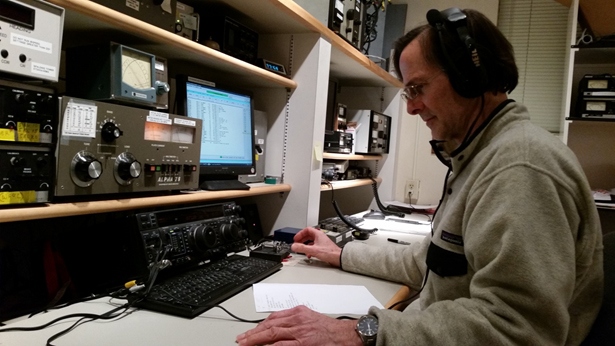Supported by Caltech Campus
During the wee hours of the morning on January 27, 2017 the Caltech Amateur Radio Club (CITARC, callsign W6UE) helped to re-enact a historical event that occurred 100 years ago. That event was the first relay of formal radio message traffic, or “radiograms,” across the United States. On January 27, 1917, three such messages were sent from Los Angeles to Denver, then relayed immediately from Denver to operators standing by in Jefferson City MO, then on to Albany NY, and finally to Hartford CT.
In modern times, amateur radio operators (often called “hams”) make contacts all over the world on the high frequency, or short wave, bands by bouncing signals off naturally ionized layers in the upper atmosphere. In 1917, however, all radio used spark gap transmission (think of the movie Titanic) in the medium frequency range, which could only be heard hundreds of miles away. The trick of getting a message from here to there was to relay it between hams until it reached its destination.
Amateur radio’s national organization in the United States, the ARRL, in fact derived its name from this prominent activity. ARRL stands for American Radio Relay League.
It would be illegal to re-enact the event with original equipment, since the noisy and imprecise spark gap technology was outlawed on the amateur bands in 1924. In the spirit of the event, however, the Caltech hams used the lowest frequency available, 1.82 megahertz (160 meters wavelength). CITARC is one of the few ham clubs in the crowded Los Angeles area that has an antenna for that frequency: a 270–foot long wire on the campus, stretching from the roof of the Firestone Laboratory to roof of Thomas Laboratory, to the roof of the Spalding Laboratory. True to history, Morse code transmission was used.
Knowledge of Morse code is no longer required to obtain an amateur radio license, but many dedicated hams worldwide still use and enjoy it. Message relay, using voice and digital modes in addition to Morse code, is now used mostly to help amateur operators prepare and train for disaster communications.
The commemorative radiogram was:
1 R W6UE 25 PASADENA CA 0801Z JAN 27
TOM GALLAGHER NY2RF
ARRL CHIEF EXECUTIVE OFFICER
225 MAIN STREET
NEWINGTON CT 06111
860 594 0200
BT
THE SPIRITS OF 6EA 9ZF
9ABD 2AGJ AND 1ZM SEND
COMMEMORATIVE GREETINGS ON THE 100TH
ANNIVERSARY OF FIRST TRANSCONTINENTAL RELAY
OF FORMAL MESSAGE TRAFFIC 73
BT
W6UE LOS ANGELES
K8ZTT DENVER
W9ABD JEFFERSON CITY
KT2D ALBANY
AR

Photo: David Hodge N6AN at the key, sending the message.
(photo credit: Kate Hutton K6HTN)
Contact:
David Hodge, N6AN, staff member Electrical Engineering
N6AN@ARRL.net
Kate Hutton, K6HTN, retired staff member Seismological Laboratory
K6HTN@ARRL.net